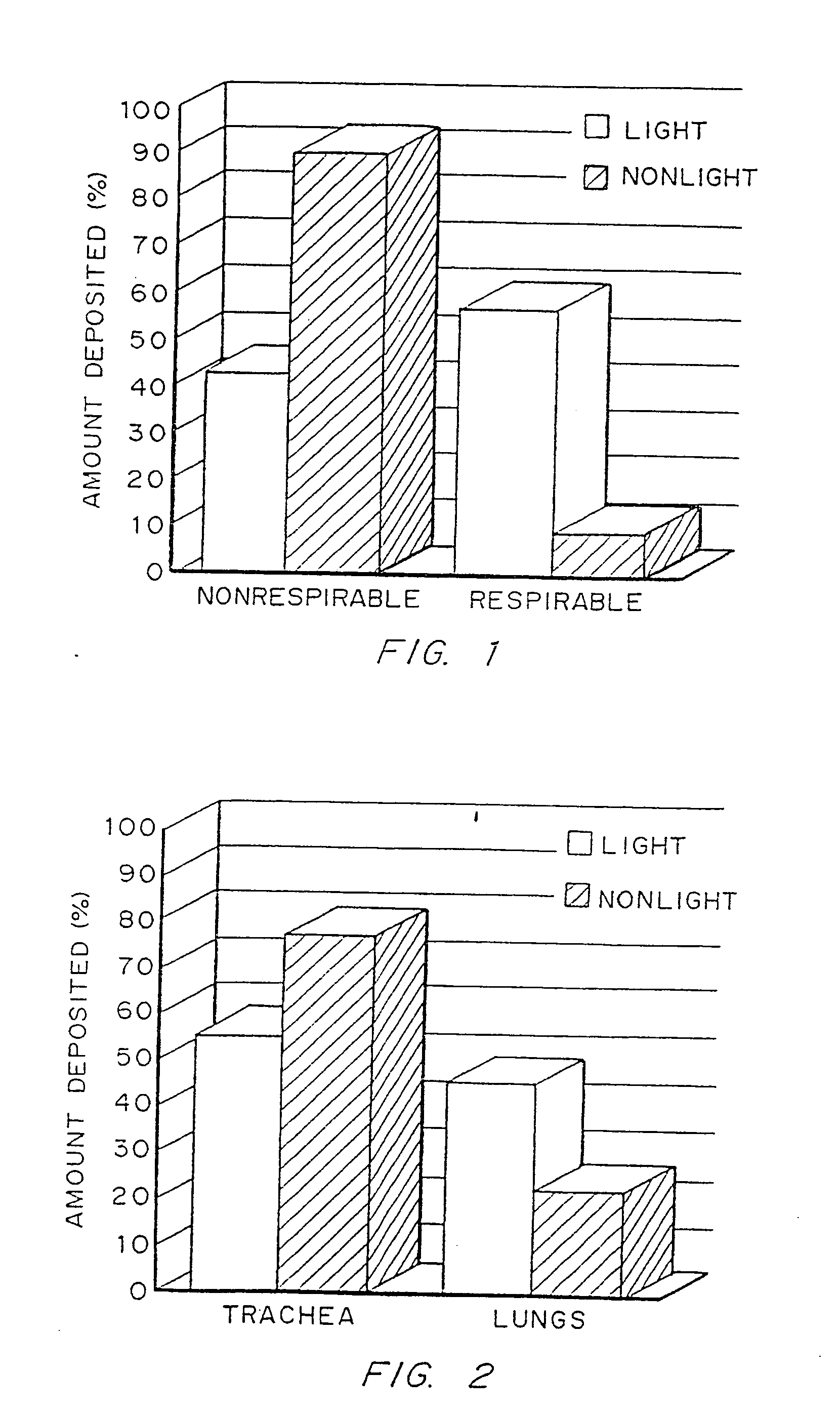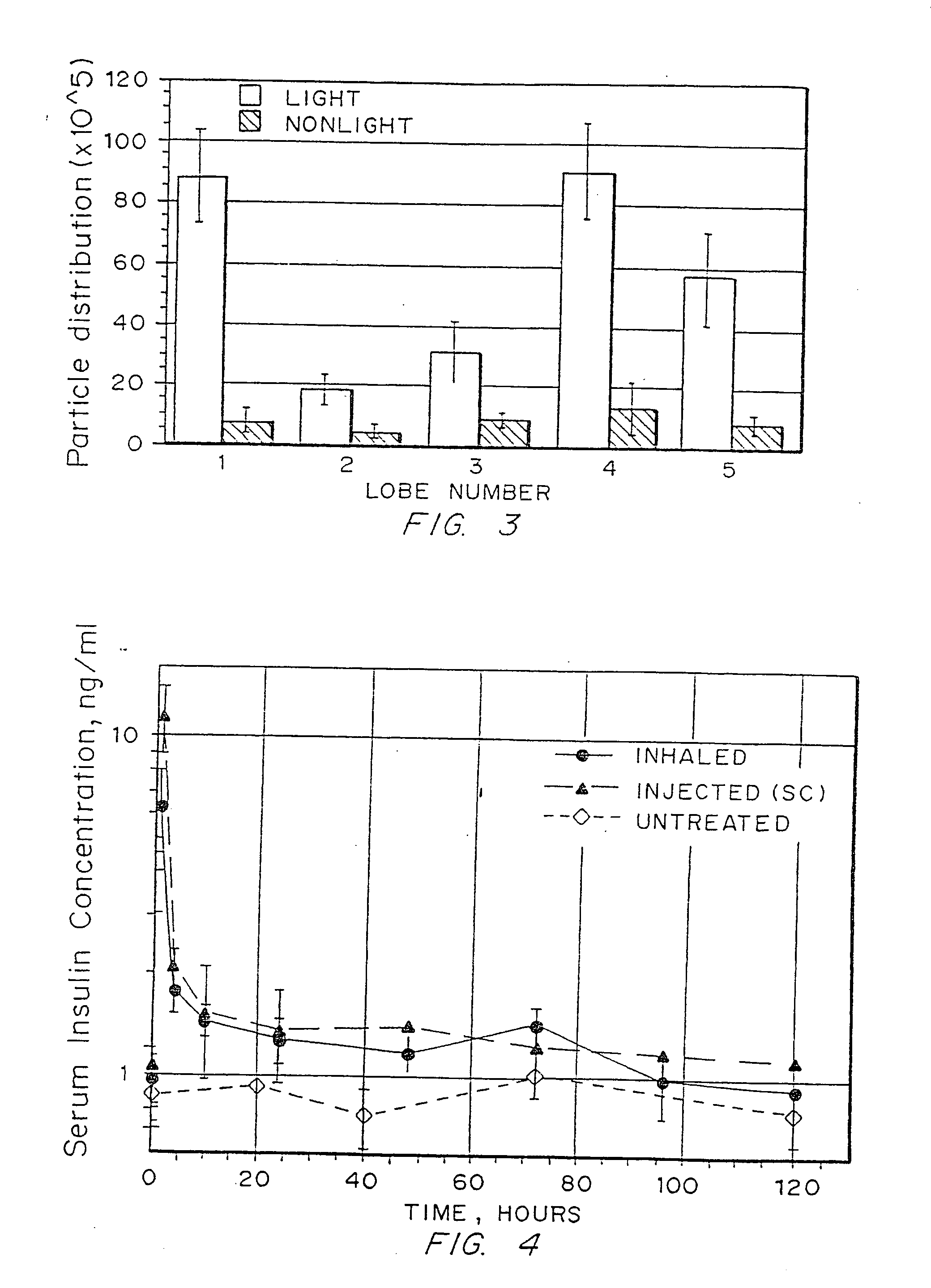Aerodynamically light particles for pulmonary drug delivery
a technology of pulmonary drug delivery and aerodynamic light particles, which is applied in the direction of drug compositions, powder delivery, peptides, etc., can solve the problems of local toxic effects, poor control of the site, and excessive loss of inhaled
- Summary
- Abstract
- Description
- Claims
- Application Information
AI Technical Summary
Benefits of technology
Problems solved by technology
Method used
Image
Examples
example 1
Synthesis of Aerodynamically Light Poly[(p-carboxyphenoxy)-hexane anhydride] (“PCPH”) Particles
[0079] Aerodynamically light poly[(p-carboxyphenoxy)-hexane anhydride] (“PCPH”) particles were synthesized as follows. 100 mg PCPH (MW approximately 25,000) was dissolved in 3.0 mL methylene chloride. To this clear solution was added 5.0 mL 1% w / v aqueous polyvinyl alcohol (PVA, MW approximately 25,000, 88 mole % hydrolyzed) saturated with methylene chloride, and the mixture was vortexed (Vortex Genie 2, Fisher Scientific) at maximum speed for one minute. The resulting milky-white emulsion was poured into a beaker containing 95 mL 1% PVA and homogenized (Silverson Homogenizers) at 6000 RPM for one minute using a 0.75 inch tip. After homogenization, the mixture was stirred with a magnetic stirring bar and the methylene chloride quickly extracted from the polymer particles by adding 2 mL isopropyl alcohol. The mixture was stirred for 35 minutes to allow complete hardening of the micropartic...
example 2
Synthesis of PLAL-Lys and PLAL-Lys-Ala Polymeric and Copolymeric Particles
[0081] Aerodynamically Light PLAL-Lys Particles
[0082] PLAL-Lys particles were prepared by dissolving 50 mg of the graft copolymer in 0.5 ml dimethylsulfoxide, then adding 1.5 ml dichloromethane dropwise. The polymer solution is emulsified in 100 ml of 5% w / v polyvinyl alcohol solution (average molecular weight 25 KDa, 88% hydrolyzed) using a homogenizer (Silverson) at a speed of approximately 7500 rpm. The resulting dispersion was stirred using a magnetic stirrer for 1 hour. Following this period, the pH was brought to between 7.0 and 7.2 by addition of a 0.1 N NaOH solution. Stirring was continued for an additional 2 hours until the dichloromethane was completely evaporated and the particles hardened. The particles were then isolated by centrifugation at 4000 rpm (1600 g) for 10 minutes (Sorvall RC-5B). The supernatant was discarded and the precipitate washed three times with distilled water followed by cen...
example 3
Synthesis of Spray-Dried Particles
[0090] Aerodynamically Light Particles Containing Polymer and Drug Soluble in Common Solvent
[0091] Aerodynamicatiy light 50:50 PLGA particles were prepared by spray drying with testosterone encapsulated within the particles according to the following procedures. 2.0 g poly (D,L-lactic-co-glycolic acid) with a molar ratio of 50:50 (PLGA 50:50, Resomer RG503, B. I. Chemicals, Montvale, N.J.) and 0.50 g testosterone (Sigma Chemical Co., St. Louis, Mo.) were completely dissolved in 100 mL dichloromethane at room temperature. The mixture was subsequently spraydried through a 0.5 mm nozzle at a flow rate of 5 mL / min using a Buchi laboratory spray-drier (model 190, Buchi, Germany). The flow rate of compressed air was 700 nl / h. The inlet temperature was set to 30° C. and the outlet temperature to 25° C. The aspirator was set to achieve a vacuum of −20 to −25 bar. The yield was 51% and the mean particle size was approximately 5 μm. The particles were aerod...
PUM
| Property | Measurement | Unit |
|---|---|---|
| aerodynamic diameter | aaaaa | aaaaa |
| aerodynamic diameter | aaaaa | aaaaa |
| mass mean diameter | aaaaa | aaaaa |
Abstract
Description
Claims
Application Information
 Login to View More
Login to View More - R&D
- Intellectual Property
- Life Sciences
- Materials
- Tech Scout
- Unparalleled Data Quality
- Higher Quality Content
- 60% Fewer Hallucinations
Browse by: Latest US Patents, China's latest patents, Technical Efficacy Thesaurus, Application Domain, Technology Topic, Popular Technical Reports.
© 2025 PatSnap. All rights reserved.Legal|Privacy policy|Modern Slavery Act Transparency Statement|Sitemap|About US| Contact US: help@patsnap.com



